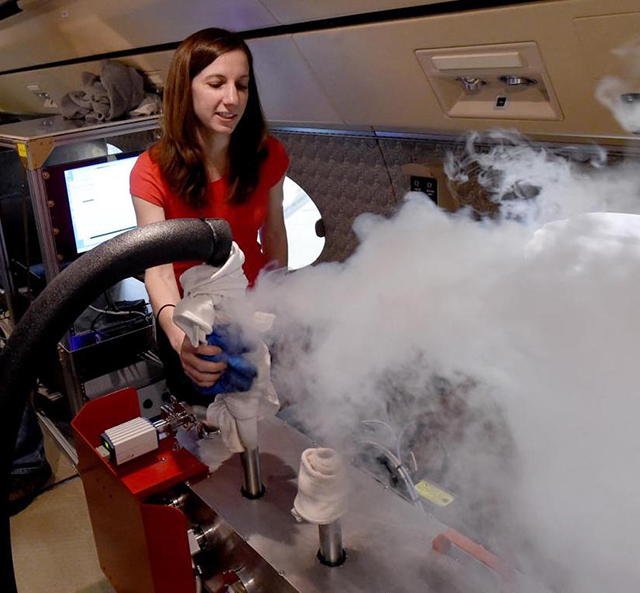Harvard School of Engineering and Applied Sciences alumna, Jenna Samra, Ph.D. ’18 (applied physics), has won the International Astronomical Union’s Ph.D. Prize (from Division E: Sun and Heliosphere) for her thesis entitled “An Airborne Infrared Spectrometer for Coronal Observations: Development, Characterization and First Science Results from the 2017 Solar Eclipse.”
The IAU Ph.D. Prize recognizes excellence in astrophysics of Ph.D. students around the globe, division E denoting achievement in the study of the variability, activity, and dynamics of the sun and its impact on the Earth and other bodies within the heliosphere. The prize is awarded annually, providing a travel grant to the IAU General Assembly in South Korea and an invitation to give a talk.
Samra was awarded this prestigious prize for her work on an air-spectrometer instrument flown on a National Science Foundation (NSF) Gulfstream V research plane to measure the infrared emission features in the solar corona, such as the wavelengths and intensities of different regions of key excited atoms, during the 2017 solar eclipse. These measurements were used to determine the intensity gradients from the limb outwards, study the radiative excitation of each line, and search for time-varying Doppler velocities, which led Samra and her team to make the first observations of a highly excited infrared Fe IX line and identify radiative contributions as a function of the radius. This observation and the measurements taken are extremely significant, as they “have the potential to enhance our understanding of coronal dynamics and improve space weather forecasting models,” wrote the Center for Astrophysics | Harvard & Smithsonian (CfA), with which Samra has been conducting her research.
Samra’s work does not stop here, however. She and the eclipse team plan to use the same air-spectrometer to obtain new information and validate the data collected from the 2017 campaign during the upcoming 2019 solar eclipse. She has also been working on a proposal, entitled “MRI: Development of an Airborne Stabilized Platform for Infrared Experiments (ASPIRE),” which has been recommended for funding by the NSF. The goal of this proposal is to provide a solid platform for IR instrumentation development prior to the 2024 U.S. total solar eclipse. Beyond this, she is the instrumental scientist for “Methane Air,” a privately funded project to identify sources of methane leaks and has participated in the design of the Coronal Imaging Spectrograph in the EUV (COSIE), a NASA Mission of Opportunity proposal currently under consideration.

This image shows Samra with AIR-Spec. (Photo by Cliff Grassmick, dailycamera.com)
Share Your News
Have you made the headlines? Do you have news to share with your classmates and colleagues? Send your news items and photos to azewe@seas.harvard.edu.
